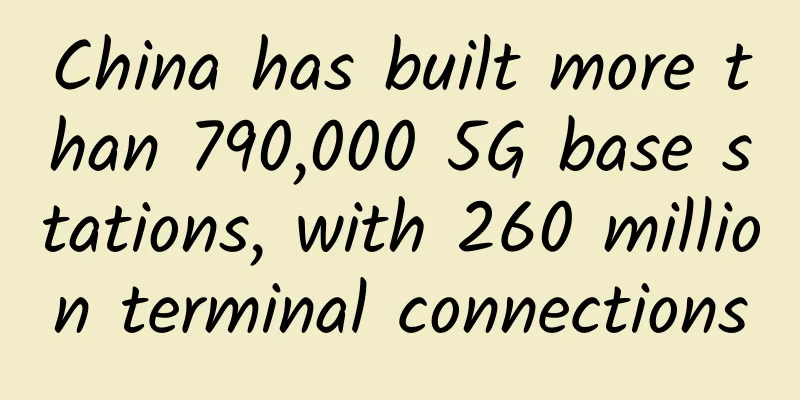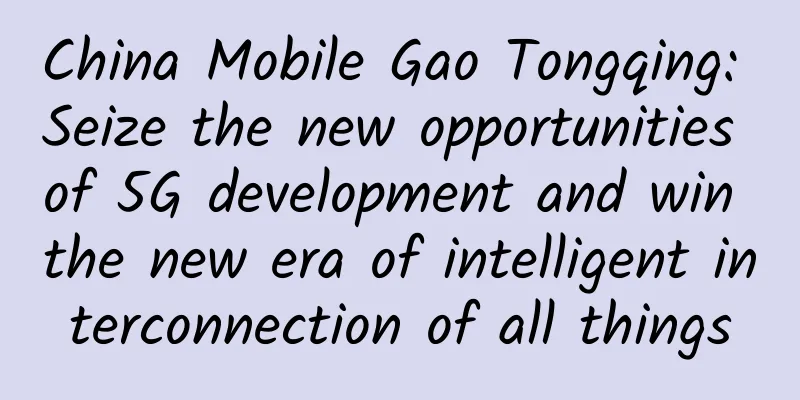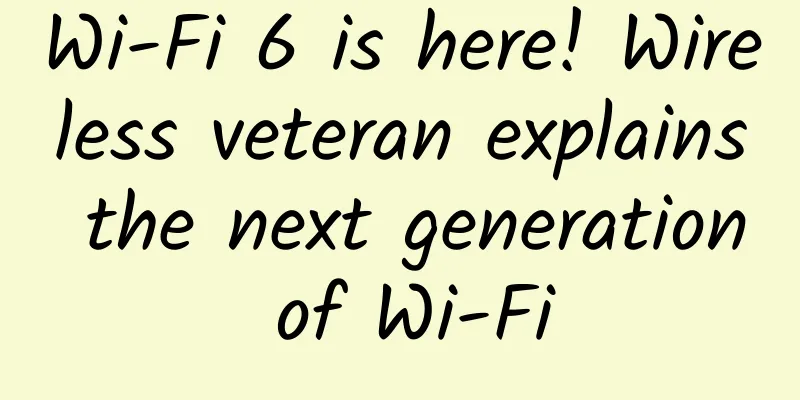How does 5G use spectrum? This article tells you everything!

|
As we all know, wireless spectrum resources are the lifeblood of mobile networks and are very scarce. In order to improve spectrum utilization, mobile communication technology has been constantly innovating. This article will tell you about a great wireless technology innovation process. 1. Spectrum is a valuable resource for mobile communications Let's first understand what is wireless spectrum? What is carrier? What is carrier bandwidth? When we pick up our mobile phones to surf the Internet, the data stream is carried on radio waves of a specific frequency and transmitted to the mobile phone through the base station antenna. This radio wave of a specific frequency is the wireless spectrum. The radio wave that carries the data stream is called a carrier. The wireless frequency band width of the carrier is called the carrier bandwidth. The carrier is like a highway, carrying data back and forth between the mobile phone and the base station. The larger the carrier bandwidth, the more data flow can be transmitted per unit time, just like the wider the road, the more and faster the traffic, and the faster the wireless network speed. To this end, from 1G to 5G, operators have built wider and wider roads. As shown in the figure above, the single-carrier bandwidth of 3G WCDMA is 5MHz, the single-carrier bandwidth of 4G LTE is up to 20MHz, and the 5G NR is further increased to 100MHz. But this continuous road construction has also brought some problems. (1) Spectrum resources are becoming increasingly scarce With the arrival of each G, operators have to build a separate road for this G, and the roads are getting wider and wider. In other words, 2G occupies a section of spectrum, 3G occupies a section of spectrum, 4G occupies another section of spectrum, and 5G occupies another section of spectrum. Different 2/3/4/5G standards have to occupy a section of spectrum exclusively and cannot be shared, which leads to the increasing shortage of limited wireless spectrum resources. (2) Waste of spectrum resources For example, as the number of 2G users decreases, the traffic on this road decreases, while as the number of 4G users increases, the traffic on this road becomes more and more congested. However, the 2G and 4G roads are independent of each other and cannot be shared, resulting in uneven distribution and waste of resources. (3) Serious spectrum fragmentation In addition, due to historical reasons such as spectrum allocation for each G, spectrum splitting and auctioning (mainly overseas) and frequency re-cultivation, spectrum fragmentation has also occurred. Taking 4G as an example, the standard organization initially allocated about 44 available frequency bands between 400 and 3800MHz for LTE, but as the scale of LTE network deployment continues to expand, it is predicted that more and more LTE networks will be deployed in multiple frequency bands, making spectrum fragmentation more and more serious. The problem caused by these phenomena is that since the network capacity and throughput that each spectrum segment can provide are limited, the utilization rate and overall value of limited spectrum resources are not fully utilized. What to do? A great innovative technology in the history of wireless was born - carrier aggregation. 2. A great technological innovation: carrier aggregation In order to meet the people's ever-increasing demand for network speed, in the 4G era, 3GPP proposed that the downlink peak rate should reach 1 Gbps in the LTE-A (4.5G) stage. However, the maximum bandwidth of a single LTE carrier is only 20M, and the maximum downlink peak rate is only 150Mbps. What should we do? Carrier aggregation (CA) technology came into being. Carrier aggregation is the process of “stitching” fragmented frequency bands into a wider frequency band. It can aggregate continuous carriers within the same frequency band, non-continuous carriers within the same frequency band, or non-continuous carriers on different frequency bands. It is this “aggregatable non-continuous carrier” that crowns carrier aggregation as “a great technological innovation in the history of wireless.” As we all know, compared with 3G, 4G uses MIMO technology to double the network speed, but before that MIMO has been applied to Wi-Fi and WiMAX; Wi-Fi can bundle two channels together to expand bandwidth and improve network speed, but they can only be adjacent channels. Only 4G carrier aggregation technology has made it possible for the first time to "stitch" together non-continuous carriers on different frequency bands. If demand is the driving force behind invention, then carrier aggregation technology has three driving forces: one is the need to increase network speed, another is the need to solve spectrum fragmentation, and the other is the need to improve spectrum utilization. For example, carrier aggregation can merge three independent 4G roads at 800MHz, 1.8GHz and 2.6GHz into one wide avenue, thereby greatly improving the 4G peak rate, solving the problem of spectrum fragmentation and improving spectrum utilization. 4G LTE-A can support 5CC carrier aggregation, which means that the maximum single carrier bandwidth (20MHz) of 5 LTEs can be combined into 100MHz, thereby increasing the downlink peak rate from 150Mbps to 1Gbps. LTE-A pro can also support 32CC carrier aggregation. Carrier aggregation is a great technological innovation and has been widely adopted by 4G networks. Unfortunately, it has failed to break through another high mountain on the road to improving wireless spectrum utilization - achieving "carrier aggregation" between networks of different standards. However, the pace of wireless technology innovation never stops. Then, another milestone innovation came on the scene. 3. Milestone Technological Innovation: Dynamic Spectrum Sharing The evolution of each G has greatly improved spectrum efficiency. Therefore, making as much spectrum resources as possible serve the latest mobile communication technologies is the right way to give new vitality to the old spectrum. The simplest and most direct way is to refarm the spectrum, freeing up the spectrum occupied by the old mobile network for the new network, such as retiring the 2G network to free up spectrum resources for 4G. The dirt road used to be muddy, but now it has been upgraded to asphalt, which makes good use of the land resources and increases the speed of vehicles. But the actual situation is not that simple. Since operators' networks now have multiple standards coexisting including 2G, 3G, 4G and 5G, such a one-size-fits-all approach may harm consumer interests and is not conducive to a smooth transition of multiple standards. Therefore, Dynamic Spectrum Sharing (DSS) came into being, allowing networks of different standards to share the same spectrum resources. For example, dynamic spectrum sharing technology can intelligently and dynamically allocate spectrum between 4G and 5G, thereby achieving efficient use of spectrum resources. With dynamic spectrum sharing combined with carrier aggregation technology, operators can connect 4G and 5G spectrum resources, improve resource utilization efficiency, and help operators flexibly and efficiently implement technology iteration. Taking China Mobile's 160MHz bandwidth as an example, this 160MHz is composed of 100MHz NR and 60MHz LTE. In the early stage of 4G to 5G evolution, the 5G business volume is still unstable. In order to avoid resource waste, 40MHz shared spectrum can be dynamically scheduled to serve 4/5G. When there are fewer 5G users and more 4G services, LNR 40M can expand 4G capacity, and LTE can further increase the rate by increasing the number of carriers and using carrier aggregation. When there are busy 5G users and less pressure on 4G, LNR 40M can dynamically expand the 5G spectrum bandwidth to increase 5G capacity. In this way, China Mobile fully utilizes the 160MHz bandwidth resources without waste, while fully ensuring the 4G experience and achieving smooth evolution from 4G to 5G. Dynamic spectrum sharing is the first time that the same spectrum resources are shared between different standards, which can be said to be a milestone technological innovation in the history of mobile communication development. This technology is called CloudAIR in Huawei. This name intuitively explains the core idea of dynamic spectrum sharing, namely "spectrum cloudification" and on-demand use. But innovation and breakthroughs are never easy, and as the spectrum bandwidth supported by 5G becomes larger and larger, technological breakthroughs become more difficult. So, how difficult is it to achieve 4G/5G dynamic spectrum sharing under large bandwidth? And how to overcome it? 4. To make full use of the spectrum, you also need the ultimate performance of software and hardware to ensure Dynamic spectrum sharing works in an environment where multiple standards coexist. It performs resource scheduling across two networks of different standards in real time according to traffic changes. Therefore, it is necessary to accurately control interference from different standards and between uplink and downlink, and achieve a resource scheduling response speed of milliseconds. If the algorithm is not in place, it will affect the performance of the mobile communication network, such as congestion and dropped calls. In addition, in terms of hardware, the spectrum bandwidth capability that wireless equipment (mainly AAU) can support is also a key technical indicator. For example, some operators implement dynamic spectrum sharing in the frequency band below 1GHz, and the total supported bandwidth may be less than 20MHz; while China Mobile wants to implement dynamic spectrum sharing in the 2.6GHz frequency band, requiring a supported bandwidth of 160MHz. Some countries even require a wider supported bandwidth due to severe spectrum fragmentation. What happens if the device cannot support bandwidths above 160MHz? Taking China Mobile's 160MHz bandwidth as an example, if the equipment only supports 100MHz bandwidth, it means that the operator has to deploy two sets of equipment, one supporting 100MHz and one supporting 60MHz. This not only cannot support dynamic spectrum sharing within the 160MHz bandwidth, but also greatly increases network costs. It's like even if the road is wider, but the equipment capacity can't keep up, it won't run smoothly. In fact, carrier aggregation also faces the problem of large spectrum span, so carrier aggregation + dynamic spectrum sharing + large bandwidth equipment is a very competitive combination in the 5G era. At present, the capabilities of manufacturers' hardware equipment in these aspects vary, because this involves a lot of underlying technology research including chips, materials, heat dissipation, algorithms, etc. To clarify this issue, let’s start with the basic working principle of base stations. As shown in the figure above, AAU is mainly composed of digital signal processing, RF, power amplifier, filter and antenna. Digital signal processing includes baseband and digital intermediate frequency. The performance of intermediate frequency is extremely critical and determines the core hardware indicators of AAU. Taking signal transmission as an example, the baseband signal is the original digital signal that needs to be transmitted, and the radio frequency is a high-frequency signal modulated by a carrier frequency (such as C band), which is transmitted by the antenna after amplification and filtering. The power amplifier is a nonlinear device. The wider the spectrum, the harder it is to ensure its amplification performance, just like when the volume of a speaker is turned up too high, the sound will be broken. In addition, since 5G transmits a huge amount of data per unit time, it also places higher requirements on the processing capability of digital signals, which limits the instantaneous bandwidth (IBW) of the AAU. The digital intermediate frequency (DIF) is what connects the baseband and RF, up-converting and pre-processing the baseband signal, laying a solid foundation for the RF to perform analog-to-digital conversion and carrier modulation. The key to the breakthrough is that the AAU must have a large bandwidth and provide the RF with high-speed and reliable digital signal pre-processing capabilities. Huawei has formed a unique advantage in this regard: on the one hand, Huawei's digital intermediate frequency integrates advanced digital pre-distortion (DPD algorithm), which compensates for the distortion caused by the power amplifier in advance and increases the effective amplification area of the power amplifier; on the other hand, thanks to the self-developed 7nm ASIC chip replacing FPGA, the DPD algorithm and digital signal processing are completely chip-based, and the efficiency is significantly improved. At present, Huawei's IBW can reach 200M or 400M, allowing a wider spectrum to be used more effectively. Another huge challenge for AAU is power consumption, which is also an expense that cannot be ignored in 5G operations. Power amplifiers are large power consumers, and they generate some ineffective heat during the energy conversion process. Optimizing the efficiency of power amplifiers is undoubtedly the key to solving the power consumption problem. In this regard, Huawei took the lead in using gallium nitride (GaN) with better high-frequency characteristics as the power amplifier material, combined with the DPD algorithm of the intermediate frequency, to achieve industry-leading power amplifier efficiency. In addition, Huawei's self-developed ASIC and RFSoC technology make AAU more integrated, and combined with the whole machine heat dissipation technology, it further reduces the size and power consumption of the device. At the same time, the use of lightweight ceramic filters effectively controls the weight of AAU. It is precisely these underlying technology breakthroughs and end-to-end optimization that have enabled Huawei's 5G AAU equipment to be at the forefront of the industry in terms of performance, power consumption, size and weight. It is precisely because these wireless technologies continue to make breakthroughs and advances that we can see that the ultimate dream that the wireless industry has been pursuing is getting closer step by step. So what is the ultimate dream of the wireless industry? In order to maximize the utilization of spectrum resources, our ultimate dream is to change the past way of pre-allocating and monopolizing spectrum resources for wireless networks of different standards and types. On the basis of supporting ultra-bandwidth, through spectrum cloudification, software-defined, artificial intelligence and spectrum sensing capabilities, we can automatically and flexibly dynamically allocate spectrum resources for wireless networks of different standards and types according to different communication needs. Carrier aggregation unprecedentedly aggregates non-continuous carriers on different frequency bands into a larger bandwidth, and dynamic spectrum sharing enables networks of different standards to flexibly and dynamically allocate the same spectrum resources. These innovative breakthroughs mean that we are moving step by step towards the ultimate dream of the wireless industry. Innovation never stops, and the pursuit of dreams never ceases. In order to make limited spectrum resources burst out with greater value, I believe that there will be more exciting wireless technology innovation stories waiting for us in the future. |
<<: The turning point has arrived: NB-IoT industry is accelerating its release!
>>: How to unleash greater potential of new infrastructure
Recommend
Can't catch the three-way handshake process? Then come and catch a packet with me!
Some time ago, I was busy with a robot communicat...
PwC: By 2030, 5G will contribute $1.3 trillion to global GDP growth
On February 10, foreign media reported that a rep...
Gartner Report: Enterprise Network Services Market Trends for SD-WAN and NFV
As SD-WAN and Internet adoption in enterprise WAN...
The cumulative number of 5G package users of the three major operators has exceeded 300 million and has been announced
Recently, China Unicom announced its full-year pe...
How does SD-WAN compare to VPN?
When enterprises compare SD-WAN vs. VPN services,...
The secrets of the black industry: the things about the "coding platform"
Introduction The rapid development of Internet bu...
A leap from concept to practice! How does the cloud's native "immune system" fight organically?
On July 16, the Alibaba Cloud Native Security Onl...
PacificRack: Windows VPS in Los Angeles Data Center starting at $12 per year
PacificRack has released several discounted VPS p...
Sharktech: Los Angeles 1Gbps unlimited traffic high-security server starting at $59/month
Sharktech has been offering a promotion for 1Gbps...
Limited edition package replenishment for BandwagonHost $46.6/year, CN2 GIA (DC6/DC9)/Japan SoftBank optional
Bandwagonhost has just restocked a limited editio...
Are the Prague Proposals issued by 32 countries targeting China's 5G? No, there is a new opportunity behind it.
In Prague Square, white doves are facing the suns...
AkkoCloud: UK CN2 GIA/Germany CN2 GIA/US CN2 GIA high bandwidth VPS quarterly payment starts from 99 yuan
We know that the CN2 GIA line is one of the relat...
Servervy: €1.5/month-2GB/10GB SSD/100M unlimited traffic/Netherlands VPS
The whois query of the domain name Servervy.com s...
ZJI Double 11 recharge 1000 yuan to get 100 yuan, Hong Kong high-defense server lifetime 50% discount, regular server 20% discount
ZJI was founded in 2011 as Weixiang Host, a well-...
ITBBU: A beautiful encounter between 5G and NFV
Recently, as an annual event in the field of mobi...









